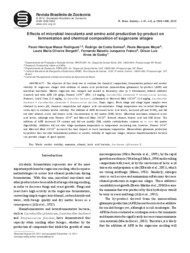Effects of microbial inoculants and amino acid production by-product on fermentation and chemical composition of sugarcane silages.
Effects of microbial inoculants and amino acid production by-product on fermentation and chemical composition of sugarcane silages.
Author(s): RODRIGUES, P. H. M.; GOMES, R. da C.; MEYER, P. M.; BORGATTI, L. M. O.; FRANCO, F. M. J.; GODOY, G. L. A. de
Summary: The objective of this study was to evaluate the chemical composition, fermentation patterns and aerobic stability of sugarcane silages with addition of amino acid production (monosodium glutamate) by-product (APB) and microbial inoculants. Mature sugarcane was chopped and ensiled in laboratory silos (n = 4/treatment) without additives (control) and with APB (10 g/kg), Pioneer 1174® (PIO, 1.0 mg/kg, Lactobacillus plantarum + Streptoccoccus faecium, Pioneer), Lalsil Cana (2.0 mg/kg, Lactobacillus buchineri, Lallemand) or Mercosil Maís 11C33® (1.0 mg/kg, Lactobacillus buchineri + Lactobacillus plantarum + Streptoccoccus faecium, Timac Agro). Fresh silage and silage liquor samples were obtained to assess pH, chemical composition and organic acid concentrations. Silage temperature was recorded throughout seven days to evaluate aerobic stability. The addition of APB decreased lactic acid levels, increased pH and N-NH3 and did not alter ethanol, acetic and butyric acids concentrations or dry matter (DM) losses. Microbial inoculants enhanced acetic acid levels, although only Pioneer 1174® and Mercosil Maís 11C33® lowered ethanol, butyric acid and DM losses. The addition of APB increased CP content and did not modify DM, soluble carbohydrates contents or in vitro dry matter digestibility. Additives did not alter silage maximum temperature or temperature increasing rate; however, Pioneer 1174® and Mercosil Maís 11C33® increased the time elapsed to reach maximum temperature. Monosodium glutamate production by-product does not alter fermentation patterns or aerobic stability of sugarcane silages, whereas homofermentative bacteria can provide silages of good quality.
Publication year: 2012
Types of publication: Journal article
Unit: Embrapa Beef Cattle
Keywords: Cana-de-açúcar, Inoculante, Sialgem
Observation
Some of Embrapa's publications are published as ePub files. To read them, use or download one of the following free software options to your computer or mobile device. Android: Google Play Books; IOS: iBooks; Windows and Linux: Calibre.
Access other publications
Access the Agricultural Research Database (BDPA) to consult Embrapa's full library collection and records.
Visit Embrapa Bookstore to purchase books and other publications sold by Embrapa.

